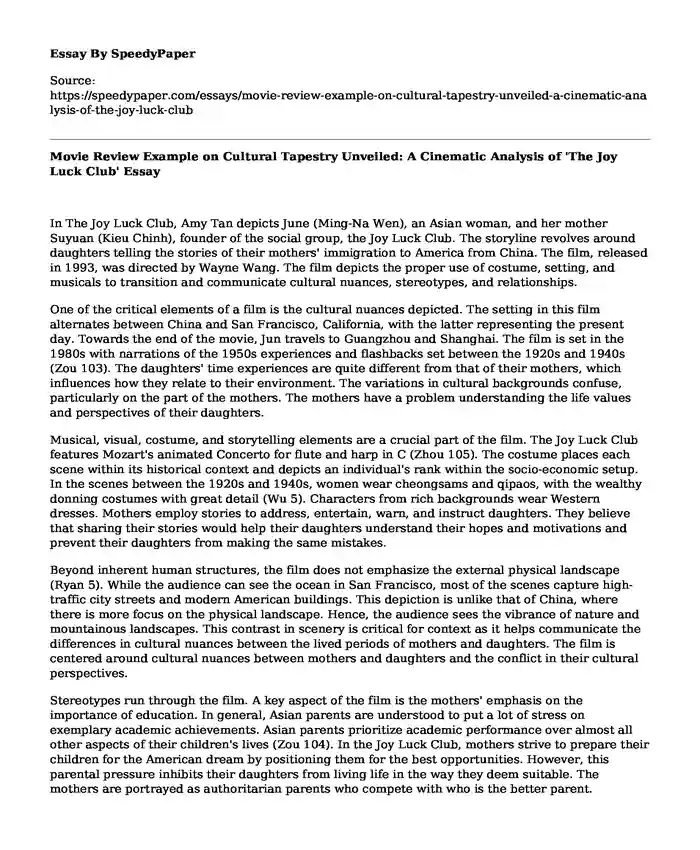
| Essay type: | Analytical essays |
| Categories: | Music History Movie |
| Pages: | 3 |
| Wordcount: | 733 words |
In The Joy Luck Club, Amy Tan depicts June (Ming-Na Wen), an Asian woman, and her mother Suyuan (Kieu Chinh), founder of the social group, the Joy Luck Club. The storyline revolves around daughters telling the stories of their mothers' immigration to America from China. The film, released in 1993, was directed by Wayne Wang. The film depicts the proper use of costume, setting, and musicals to transition and communicate cultural nuances, stereotypes, and relationships.
One of the critical elements of a film is the cultural nuances depicted. The setting in this film alternates between China and San Francisco, California, with the latter representing the present day. Towards the end of the movie, Jun travels to Guangzhou and Shanghai. The film is set in the 1980s with narrations of the 1950s experiences and flashbacks set between the 1920s and 1940s (Zou 103). The daughters' time experiences are quite different from that of their mothers, which influences how they relate to their environment. The variations in cultural backgrounds confuse, particularly on the part of the mothers. The mothers have a problem understanding the life values and perspectives of their daughters.
Musical, visual, costume, and storytelling elements are a crucial part of the film. The Joy Luck Club features Mozart's animated Concerto for flute and harp in C (Zhou 105). The costume places each scene within its historical context and depicts an individual's rank within the socio-economic setup. In the scenes between the 1920s and 1940s, women wear cheongsams and qipaos, with the wealthy donning costumes with great detail (Wu 5). Characters from rich backgrounds wear Western dresses. Mothers employ stories to address, entertain, warn, and instruct daughters. They believe that sharing their stories would help their daughters understand their hopes and motivations and prevent their daughters from making the same mistakes.
Beyond inherent human structures, the film does not emphasize the external physical landscape (Ryan 5). While the audience can see the ocean in San Francisco, most of the scenes capture high-traffic city streets and modern American buildings. This depiction is unlike that of China, where there is more focus on the physical landscape. Hence, the audience sees the vibrance of nature and mountainous landscapes. This contrast in scenery is critical for context as it helps communicate the differences in cultural nuances between the lived periods of mothers and daughters. The film is centered around cultural nuances between mothers and daughters and the conflict in their cultural perspectives.
Stereotypes run through the film. A key aspect of the film is the mothers' emphasis on the importance of education. In general, Asian parents are understood to put a lot of stress on exemplary academic achievements. Asian parents prioritize academic performance over almost all other aspects of their children's lives (Zou 104). In the Joy Luck Club, mothers strive to prepare their children for the American dream by positioning them for the best opportunities. However, this parental pressure inhibits their daughters from living life in the way they deem suitable. The mothers are portrayed as authoritarian parents who compete with who is the better parent.
Conclusion
In conclusion, the analysis of the film The Joy Luck Club reveals the use of multiple elements. Musical elements are revealed in the use of Mozart's Concerto, while costumes help to place scenes in their historical contexts. The external setting helps to contrast the settings and place them in their contexts. In San Francisco, modern American buildings populate the external environment and depict modernity while the natural landscape of China depicts the underdeveloped past. Similar contrasts are also revealed in costumes, with costumes for wealthy characters having more detail and more Western than costumes for the poor. Lastly, stereotypes help to portray the traits of the characters, with the Asian mothers being strict and placing excess value on education.
Works Cited
Ryan, Michael, and Melissa Lenos. An introduction to film analysis: Technique and meaning in narrative film. Bloomsbury Publishing USA, 2020.
Wu, Bao-qin, et al. "A Comparative Study of Cultural Values in Chinese and American Parenting Reflected in The Joy Luck Club." International Journal of English Linguistics, vol. 10, no. 2, 2020, www.researchgate.net/publication/339096739_A_Comparative_Study_of_Cultural_Values_in_Chinese_and_American_Parenting_Reflected_in_The_Joy_Luck_Club
Zou, Xiaowei. "The Construction of Identity in the Process of Cultural Integration---Take the joy Luck Club as an example." International Journal, vol. 7, no.1, 2019, pp. 103-107, www.ijll-net.com/journals/ijll/Vol_7_No_1_June_2019/12.pdf
Cite this page
Movie Review Example on Cultural Tapestry Unveiled: A Cinematic Analysis of 'The Joy Luck Club'. (2023, Dec 26). Retrieved from https://speedypaper.net/essays/movie-review-example-on-cultural-tapestry-unveiled-a-cinematic-analysis-of-the-joy-luck-club
Request Removal
If you are the original author of this essay and no longer wish to have it published on the SpeedyPaper website, please click below to request its removal:
- Essay Example with Music Production Analysis
- Essay Example on American Medical News
- Essay Sample for Everyone: Movies and the Impact of Images
- The Passion of the Christ - Movie Review Essay Sample
- Free Essay Analyzing the Impact of Social Media on PUMA Company
- Response Paper Example for Post on US Industries' Changes in Modern World
- Split-Screen in Chelsea Girls - Free Paper Sample
Popular categories




